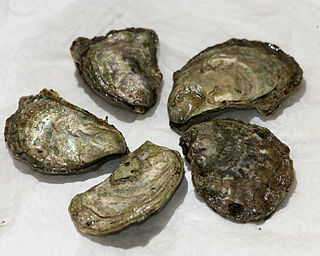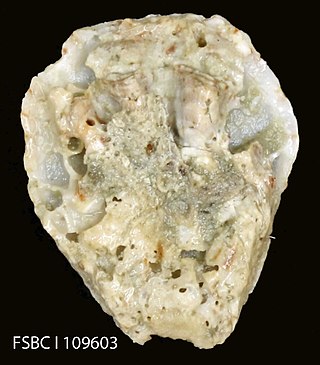
Clam is a common name for several kinds of bivalve mollusc. The word is often applied only to those that are edible and live as infauna, spending most of their lives halfway buried in the sand of the sea floor or riverbeds. Clams have two shells of equal size connected by two adductor muscles and have a powerful burrowing foot. They live in both freshwater and marine environments; in salt water they prefer to burrow down into the mud and the turbidity of the water required varies with species and location; the greatest diversity of these is in North America.

The Lapita culture is the name given to a Neolithic Austronesian people and their distinct material culture, who settled Island Melanesia via a seaborne migration at around 1600 to 500 BCE. The Lapita people are believed to have originated from the northern Philippines, either directly, via the Mariana Islands, or both. They were notable for their distinctive geometric designs on dentate-stamped pottery, which closely resemble the pottery recovered from the Nagsabaran archaeological site in northern Luzon. The Lapita intermarried with the Papuan populations to various degrees, and are the direct ancestors of the Austronesian peoples of Polynesia, eastern Micronesia, and Island Melanesia.

Donax is a genus of small, edible saltwater clams, marine bivalve molluscs with highly variable color patterns. The genus is sometimes known as bean clams or wedge shells; however, Donax species have different common names in different parts of the world. In the southeastern U.S. they are known as "coquina", a word that is also used for the hard limestone concretions of their shells and those of other marine organisms. They are called "Chip Chip" in Trinidad & Tobago and "Chipi Chipi" in Venezuela, "Stumpfmuschel" in German, and "Zaaje" in Dutch. In South Vanuatu Languages they are called "Kaiwi" or "Tumbar".

Ark clam is the common name for a family of small to large-sized saltwater clams or marine bivalve molluscs in the family Arcidae. Generally less than 80 mm long, ark clams vary both in shape and size. They number about 200 species worldwide.

The Nukumanu Islands, formerly the Tasman Islands, is an atoll of Papua New Guinea, located in the south-western Pacific Ocean, 4 degrees south of the Equator.

Tridacna crocea, the boring clam, crocus clam, crocea clam or saffron-coloured clam, is a species of bivalve in the family Cardiidae. It is native to the Indo-Pacific region. It is occasionally found in the aquarium trade where it is often simply referred to as crocea.

The Atlantic surf clam, also called the bar clam, hen clam, skimmer or simply sea clam, is a very large, edible, saltwater clam or marine bivalve mollusk in the family Mactridae. It is one of the most commonly found species of bivalves in the western Atlantic Ocean. Able to reach sizes between 7.9 and 8.9 inches in length, Atlantic surf clams are much larger than Spisula solida, which also resides in the eastern Atlantic coastal waters. Atlantic surf clams reproduce in late summer, when the water temperatures peak.

The rayed trough shell, is a species of edible saltwater clam, a marine bivalve mollusc in the family Mactridae, the trough shells.

Ostrea lurida, common name the Olympia oyster, after Olympia, Washington in the Puget Sound area, is a species of small, edible oyster, a marine bivalve mollusk in the family Ostreidae. This species occurs on the northern Pacific coast of North America. Over the years the role of this edible species of oyster has been partly displaced by the cultivation of non-native edible oyster species.

Lentigo lentiginosus, the silver conch, is a species of medium-sized sea snail, a marine gastropod mollusc in the family Strombidae, the true conchs.
The Everglades Pseudoatoll was a major geomorphic feature of southern Florida during the Pliocene epoch.

Mulinia lateralis, the dwarf surf clam or coot clam, is a species of small saltwater clam, a bivalve mollusc in the family Mactridae. It occurs in the western Atlantic Ocean and the Caribbean Sea.

Enigmonia is a genus of saltwater clams, a marine bivalve mollusc in the family Anomiidae, the jingle shells. Enigmonia aenigmatica, the mangrove jingle shell clam, is the only species in this monotypic genus. It is found living on mangroves in the Indo-Pacific Ocean.

Venerupis corrugata, the pullet carpet shell, is a species of bivalve mollusc in the family Veneridae. It is found buried in the sediment on the sea bed in shallow parts of the eastern Atlantic Ocean. It is harvested for human consumption in Spain and other parts of Western Europe.

Chama lazarus, common name the Lazarus jewel box, is a species of cemented saltwater clam, a marine bivalve mollusc in the family Chamidae, the jewel boxes.

Saxidomus gigantea is a large, edible saltwater clam, a marine bivalve mollusk in the family Veneridae, the venus clams. It can be found along the western coast of North America, ranging from the Aleutian Islands to San Francisco Bay. Common names for this clam include butter clam, Washington clam, smooth Washington clam and money shell.

The cuisines of Oceania include those found on Australia, New Zealand, and New Guinea, and also cuisines from many other islands or island groups throughout Oceania.

Ostrea equestris, commonly known as the crested oyster or horse oyster, is a species of bivalve mollusc in the family Ostreidae. It can be found along the Atlantic coast of North and South America, ranging from Virginia to Patagonia.

Pinctada margaritifera, commonly known as the black-lip pearl oyster, is a species of pearl oyster, a saltwater mollusk, a marine bivalve mollusk in the family Pteriidae. This species is common in the Indo-Pacific within tropical coral reefs.

Donax cuneatus, the cradle donax or cuneate wedge shell, is a species of small saltwater clam, a marine bivalve mollusc species in the family Donacidae.




















